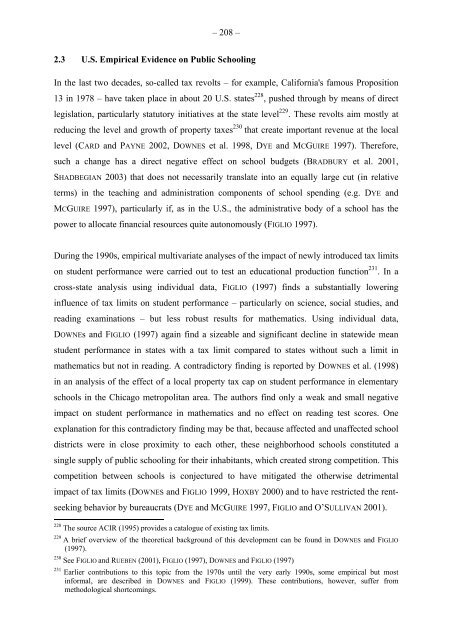The Impact of Direct Democracy on Society - Universität St.Gallen
The Impact of Direct Democracy on Society - Universität St.Gallen
The Impact of Direct Democracy on Society - Universität St.Gallen
- No tags were found...
You also want an ePaper? Increase the reach of your titles
YUMPU automatically turns print PDFs into web optimized ePapers that Google loves.
– 208 –2.3 U.S. Empirical Evidence <strong>on</strong> Public SchoolingIn the last two decades, so-called tax revolts – for example, California's famous Propositi<strong>on</strong>13 in 1978 – have taken place in about 20 U.S. states 228 , pushed through by means <str<strong>on</strong>g>of</str<strong>on</strong>g> directlegislati<strong>on</strong>, particularly statutory initiatives at the state level 229 . <str<strong>on</strong>g>The</str<strong>on</strong>g>se revolts aim mostly atreducing the level and growth <str<strong>on</strong>g>of</str<strong>on</strong>g> property taxes 230 that create important revenue at the locallevel (CARD and PAYNE 2002, DOWNES et al. 1998, DYE and MCGUIRE 1997). <str<strong>on</strong>g>The</str<strong>on</strong>g>refore,such a change has a direct negative effect <strong>on</strong> school budgets (BRADBURY et al. 2001,SHADBEGIAN 2003) that does not necessarily translate into an equally large cut (in relativeterms) in the teaching and administrati<strong>on</strong> comp<strong>on</strong>ents <str<strong>on</strong>g>of</str<strong>on</strong>g> school spending (e.g. DYE andMCGUIRE 1997), particularly if, as in the U.S., the administrative body <str<strong>on</strong>g>of</str<strong>on</strong>g> a school has thepower to allocate financial resources quite aut<strong>on</strong>omously (FIGLIO 1997).During the 1990s, empirical multivariate analyses <str<strong>on</strong>g>of</str<strong>on</strong>g> the impact <str<strong>on</strong>g>of</str<strong>on</strong>g> newly introduced tax limits<strong>on</strong> student performance were carried out to test an educati<strong>on</strong>al producti<strong>on</strong> functi<strong>on</strong> 231 . In across-state analysis using individual data, FIGLIO (1997) finds a substantially loweringinfluence <str<strong>on</strong>g>of</str<strong>on</strong>g> tax limits <strong>on</strong> student performance – particularly <strong>on</strong> science, social studies, andreading examinati<strong>on</strong>s – but less robust results for mathematics. Using individual data,DOWNEs and FIGLIO (1997) again find a sizeable and significant decline in statewide meanstudent performance in states with a tax limit compared to states without such a limit inmathematics but not in reading. A c<strong>on</strong>tradictory finding is reported by DOWNES et al. (1998)in an analysis <str<strong>on</strong>g>of</str<strong>on</strong>g> the effect <str<strong>on</strong>g>of</str<strong>on</strong>g> a local property tax cap <strong>on</strong> student performance in elementaryschools in the Chicago metropolitan area. <str<strong>on</strong>g>The</str<strong>on</strong>g> authors find <strong>on</strong>ly a weak and small negativeimpact <strong>on</strong> student performance in mathematics and no effect <strong>on</strong> reading test scores. Oneexplanati<strong>on</strong> for this c<strong>on</strong>tradictory finding may be that, because affected and unaffected schooldistricts were in close proximity to each other, these neighborhood schools c<strong>on</strong>stituted asingle supply <str<strong>on</strong>g>of</str<strong>on</strong>g> public schooling for their inhabitants, which created str<strong>on</strong>g competiti<strong>on</strong>. Thiscompetiti<strong>on</strong> between schools is c<strong>on</strong>jectured to have mitigated the otherwise detrimentalimpact <str<strong>on</strong>g>of</str<strong>on</strong>g> tax limits (DOWNES and FIGLIO 1999, HOXBY 2000) and to have restricted the rentseekingbehavior by bureaucrats (DYE and MCGUIRE 1997, FIGLIO and O’SULLIVAN 2001).228 <str<strong>on</strong>g>The</str<strong>on</strong>g> source ACIR (1995) provides a catalogue <str<strong>on</strong>g>of</str<strong>on</strong>g> existing tax limits.229 A brief overview <str<strong>on</strong>g>of</str<strong>on</strong>g> the theoretical background <str<strong>on</strong>g>of</str<strong>on</strong>g> this development can be found in DOWNES and FIGLIO(1997).230 See FIGLIO and RUEBEN (2001), FIGLIO (1997), DOWNES and FIGLIO (1997)231 Earlier c<strong>on</strong>tributi<strong>on</strong>s to this topic from the 1970s until the very early 1990s, some empirical but mostinformal, are described in DOWNES and FIGLIO (1999). <str<strong>on</strong>g>The</str<strong>on</strong>g>se c<strong>on</strong>tributi<strong>on</strong>s, however, suffer frommethodological shortcomings.
















